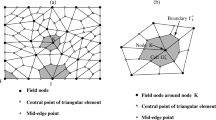Abstract
In order to resolve grid distortions in finite element method (FEM), the meshless numerical method which is called general particle dynamics (GPD) was presented to simulate the large deformation and failure of geomaterials. The Mohr-Coulomb strength criterion was implemented into the code to describe the elasto-brittle behaviours of geomaterials while the solid-structure (reinforcing pile) interaction was simulated as an elasto-brittle material. The Weibull statistical approach was applied to describing the heterogeneity of geomaterials. As an application of general particle dynamics to slopes, the interaction between the slopes and the reinforcing pile was modelled. The contact between the geomaterials and the reinforcing pile was modelled by using the coupling condition associated with a Lennard-Jones repulsive force. The safety factor, corresponding to the minimum shear strength reduction factor “R”, was obtained, and the slip surface of the slope was determined. The numerical results are in good agreement with those obtained from limit equilibrium method and finite element method. It indicates that the proposed geomaterial-structure interaction algorithm works well in the GPD framework.
Access this article
We’re sorry, something doesn't seem to be working properly.
Please try refreshing the page. If that doesn't work, please contact support so we can address the problem.
Similar content being viewed by others
References
CRUDEN D M. A simple definition of a landslide [J]. Bulletin of the International Association of Engineering Geology, 1991, 43: 27–29.
BLAIR S C, COOK N G W. Analysis of compressive fracture in rock using statistical techniques: Part I. A non-linear rule-based model [J]. International Journal of Rock Mechanics and Mining Sciences, 1998, 35(7): 837–848.
TANG C A, LIU H, LEE P K K. Numerical studies of the influence of microstructure on rock failure in uniaxial compression—Part I: Effect of heterogeneity [J]. International Journal of Rock Mechanics and Mining Sciences, 2000, 37(4): 555–569.
ASADI M S, RASOULI V, BARLA G. A bonded particle model simulation of shear strength and asperity degradation for rough rock fractures [J]. Rock Mechanics and Rock Engineering, 2012, 45(5): 649–675.
IVARS D M, PIERCE M E, DARCEL C, REYES-MONTES J. The synthetic rock mass approach for jointed rock mass modelling [J]. International Journal of Rock Mechanics and Mining Sciences, 2011, 48(2): 219–244.
ALIABADI M H, ROOKE D P. Numerical fracture mechanics [M]. Dordrecht, Netherlands: Computational Mechanics Publications and Kluwer Academic Publishers, 1991.
MONTLAUR A, FERNANDEZ-MENDEZ S, HUERTA A. High-order implicit time integration for unsteady incompressible flows [J]. International Journal for Numerical Mehods in Fluids, 2012, 70(5): 603–626.
ZHOU X P, BI J, QIAN Q H. Numerical simulation of crack growth and coalescence in rock-like materials containing multiple pre-existing flaws [J]. Rock Mechanics and Rock Engineering, 2015, 48(3): 1097–1114.
BOUSCASSE B, COLAGROSSI A, MARRONE S, ANTUONO M. Nonlinear water wave interaction with floating bodies in SPH [J]. Journal of Fluids and Structures, 2013, 42: 112–129.
PASTOR M, STICKLE M M, DUTTO P, MIRA P. A viscoplastic approach to the behavior of fluidized geomaterials with application to fast landslides [J]. Continuum Mechanics and Thermodynamics, 2015, 27(1/2): 21–47.
CHEN J K, BERAUN J E. A generalized smoothed particle hydrodynamics method for nonlinear dynamic problems [J]. Computer Methods in Applied Mechanics and Engineering, 2000, 190: 225–239.
MONAGHAN J J, RAFIEE A. A simple SPH algorithm for multi-fluid flow with high density ratios [J]. International Journal for Numerical Methods in Fluids, 2013, 71(5): 537–561.
DEWOLFE G F, GRIFFITHS D V, HUANG J S. Probabilistic and deterministic slope stability analysis by random finite elements [J]. Geotrends, 2011: 91–111.
JANBU N. Application of composite slip circles for stability analysis [C]// Proceedings of the Fourth European Conference on Stability of Earth Slopes. Stockholm, Sweden, 1954: 43–49.
ZHOU X P, CHENG H. Analysis of stability of three-dimensional slopes using the rigorous limit equilibrium method [J]. Engineering Geology, 2013, 160: 21–33.
Author information
Authors and Affiliations
Corresponding author
Additional information
Foundation item: Projects(51325903, 51279218) supported by the National Natural Science Foundation of China; Project(cstc2013kjrcljrccj0001) supported by the Natural Science Foundation Project of CQ CSTC, China; Project(20130191110037) supported by Research fund by the Doctoral Program of Higher Education of China
Rights and permissions
About this article
Cite this article
Zhao, Y., Zhou, Xp. & Qian, Qh. Progressive failure processes of reinforced slopes based on general particle dynamic method. J. Cent. South Univ. 22, 4049–4055 (2015). https://doi.org/10.1007/s11771-015-2949-0
Received:
Accepted:
Published:
Issue Date:
DOI: https://doi.org/10.1007/s11771-015-2949-0




